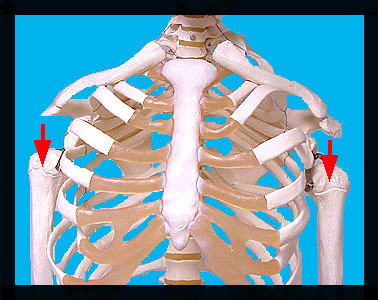|
|
|||||||||||||||||||||||||||||||||||||||||||||||||||||||||||||||||||||||||||||||||||||||||||||||||||||||||||||||||||||||
|
This image shows show a portion of the pectoral girdle with the proximal ends of the left and right humerus (indicated by the red arrows). The humerus is the only bone of the arm. There are two major groups of muscles associated with the humerus. One group extends from the pectoral girdle to the humerus and functions to move the humerus. The major processes and structures at the proximal portion of the humerus represent points of passage or attachment of these muscles. At the proximal end of the humerus the most conspicuous feature is the large, round, smooth articulating surface termed the head. The two large processes adjacent to the head are the tubercles. The lateral and larger tubercle is the greater tubercle, while the anterior, smaller tubercle constitutes the lesser tubercle. The groove between the tubercles houses one of the heads of the biceps muscle and is termed the bicipital or intertubercular groove. About midway down the diaphysis of the humerus notice a raised, rough area. This is the deltoid tuberosity, which provides a point of attachment for the deltoid muscle. At the distal end, the humerus articulates with the ulna and radius of the forearm. There are two articulating surfaces on the distal epiphysis of the humerus, the lateral ball-like capitulum and the medial pulley-shaped trochlea. Just superior to the articulating surfaces are two depressions or indentations. The smaller, anterior depression is the coronoid fossa and the larger, posterior depression is the olecranon fossa. These fossae receive the coronoid and olecranon processes of the ulna during movement of the forearm. On either side of the olecranon fossa are the lateral and medial epicondyles. |
|
